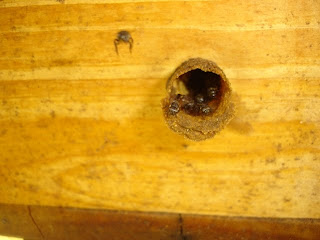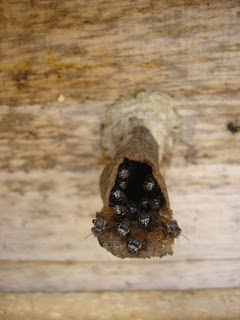Hello everyone, a very controversial and complicated issue is whether the differences in the gender Scaptotrigona bees. For this type is very common in Brazil where species are characterized by having a characteristic odor, are very populous and large producers of honey, pollen and propolis.
Most people who have any kind of this kind is not sure which is the scientific name and the vast majority or the exact species, because many of these species are very similar to each other, and some are only differentiated by small stripes, spots , coloring wings, chest, abdomen or the entry.
All I will show here and all the information comes from a lot of research on my part, and with the help of master John Peter Cappas that corrigio minor flaws and helped me develop the most accurate descriptions.
Besides that almost all Scaptotrigonas hybridize with each other, thereby making it more difficult to identify the species, because with this species is the hybrid with the second feature of species or even a 3-forming species with different input, and completely new color etc., thus becoming a "NEW" kind!
Below I will talk the most famous popular scientific name and the most common species and difficult to identify.Remembering that you are species has a slight variation depending on the state in which they are found.
Most people who have any kind of this kind is not sure which is the scientific name and the vast majority or the exact species, because many of these species are very similar to each other, and some are only differentiated by small stripes, spots , coloring wings, chest, abdomen or the entry.
All I will show here and all the information comes from a lot of research on my part, and with the help of master John Peter Cappas that corrigio minor flaws and helped me develop the most accurate descriptions.
Besides that almost all Scaptotrigonas hybridize with each other, thereby making it more difficult to identify the species, because with this species is the hybrid with the second feature of species or even a 3-forming species with different input, and completely new color etc., thus becoming a "NEW" kind!
Below I will talk the most famous popular scientific name and the most common species and difficult to identify.Remembering that you are species has a slight variation depending on the state in which they are found.
.
.
.
BENJOI (S. Polysticta)
In this species the colonies are not very aggressive as in other Scaptotrigonas. The bee has amaronzadas wings, abdomen opaque medium silver color (either 4 silver stripes, giving the abdomen the homogenous staining).The entrance of the species is almost always tilted down with reduced circumference and the end of the driveway where the bees stand guard is full of small holes. Your swarm is populous and easy multiplication.
ENTRANCE:
The circumference of the inlet is reduced, and they are few bees at its end.
Always make the entry down ... Look into the holes at the end of the entry.
TUBIBA (S. tubiba)

A bee known for its large production of honey and the authentic flavor (honey Tubiba friend Wilson Gussoni won the best honey pot of the 2010 Brazil). The bee has amaronzadas wings, the abdomen is nothing opaque stripes and dots, their input characteristic can range from just a wax around the marking entry or just a small tube of 1 to 3 cm (depending on the region where it is native ).Populous swarms with good honey production (store little pollen).
Geographical Distribution: Bahia, Rui Grande do Sul, Sergipe, Minas Gerais, Santa Catarina, São Paulo.
ENTRANCE:
The tubiba not open "tabs" of the entry to the Mandaguari and Tubuna.
Reduced circumference, and is not larger than about 3 cm.
This input below is just a tag with wax where the bees stand guard.
Mandaguari
(S. Postica)

This is the Scaptotrigona more popularly known, is the other a strong odor of coconut or gorgonzola cheese (each think a thing!). The bee has smoked wings, your abdomen is almost most of the time 2 yellow or golden stripes (and there may be up to 3 stripes). The entry of this species is very different, and basically it is a tube with a large opening at the end at the edge where the bees are (depends on the swarm population the end of input is increasingly open). Is species is very aggressive, is rolled in by the arms, legs, underarms, hair, etc. It is a major producer of honey and pollen, where very strong and old clusters are characterized by the large accumulation of pollen. Occupy large spaces, filling boxes with measures up to 30 larg. x 50 compose. x 30 am.
Geographical Distribution: Goiás, Rondônia, Santa Catarina, Rio de Janeiro, Rio Grande do Sul, Sao Paulo.
INPUTS:
The size of the input can vary greatly and can be long even very short.
In crowded clusters the number of bees at the entrance and its border is quite large.
TUBUNA
(S. bipunctata)

Is species has an odor somewhat different from Mandi and others, is stronger, with a different content. The bee is very black and bright, with good black wings or smoked, black abdomen with 2 points silverware in his final (can range from 1 silver stripe). Your input is like a horn, always open at the end, and many times the input is tilted up, and many bees in its extent. Good producer of honey and pollen.
Geographical distribution: Minas Gerais, Rio Grande do Sul, Sao Paulo, Parana, Santa Catarina.
ENTRANCE:
And black and shiny bees; many bees at the entrance; and tilt up ...
The color of the wings Tubuna may vary for smoked too (as in the photo below left).
Even the new swarms already begin to broader input and trumpet form.
Just watching the bees at the entrance you already know it is Tubuna, the black and shiny color of bees.

CONCLUSIONS:
Below I did a photo to help identify the species, where I focused the wings and the abdomen. Recalling that often due to hybridization (species have other genes, even if it is 2 or 3 crosses) may be minor changes in these characteristics.
But pure species even has the characteristics equal to those below.

Now comes the question of hybridity between species, many will be wondering why have several different species of Scaptotrigonas if they will get hybrid each other ...
But in nature they are well, I've seen forest where native found swarms of Mandi and Benjoi close to each other, and a friend in MG said on his site has many Tubunas and Mandaguaris around each other, and I received him some samples of Tubunas and I could see that some were already hybrid with Mandaguaris, and the abdomen with two silver stripes instead of 2 points.
Myself I have here in my meliponary Mandaguari, Tubuna, Tubiba and Mandi Yellow, and they are fully preserving the original characteristics of the species, that is, you simply put the groups of different species a bit distant from the other, each group in a corner of meliponary. It will not be completely sure of success but will help when the virgin queen to the mating flight a male of the same species will be next door will fertilize it.
Hope this helps everyone who still had doubts about the identification of these most common species, and I will say that all this information is 100% correct, corrected for scientific research and great masters of beekeeping.
A big hug to all and any questions just ask!




















Tidak ada komentar:
Posting Komentar